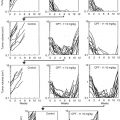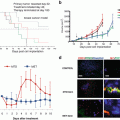© Springer International Publishing AG 2017
Robert M. Hoffman (ed.)Patient-Derived Mouse Models of Cancer Molecular and Translational Medicinehttps://doi.org/10.1007/978-3-319-57424-0_66. Techniques for Surgical Orthotopic Implantation of Human Tumors to Immunodeficient Mice
(1)
AntiCancer, Inc., 7917 Ostrow Street, San Diego, CA 92111, USA
(2)
Department of Surgery, University of California, San Diego, CA, USA
Keywords
Nude micePatient tumorsPancreatic cancerColon cancerLung cancerOvarian cancerCervical cancerBreast cancerSarcomaOrthotopicSurgical orthotopic implantationSOIPatient-derived orthotopic implantationPDOXIntroduction
This chapter is based on [1] and has been updated.
Early Nude-Mouse Models of Human Cancer
The first nude mouse of human cancer was a subcutaneous implantation of a patient colon tumor in nude mice which grew over 70 passages. However, no metastasis occurred. This was almost always the case with subcutaneous tumor implantation of tumors in immunodeficient mice, even highly malignant tumors [2].
Wang and Sordat showed that disaggregated human colon-cancer cell lines injected into the cecum of nude mice produced tumors that eventually metastasized [3]. Orthotopic injection of cell suspensions was a great improvement over simple subcutaneous implantation. However, the tumors resulting from orthotopic transplantation of cell suspensions often showed relatively low rates of metastasis compared to the original tumor in the patient [1].
Surgical Orthotopic Implantation (SOI) of Tumor Fragments
The SOI models circumvent the cell disaggregation step used in previous orthotopic models. Instead of injecting cell suspensions into the orthotopic site, we have developed microsurgical technology to transplant tumor fragments orthotopically [1]. The development of SOI technology led to increased metastatic frequency, and metastatic sites in the transplanted mice which reflect the clinical pattern after SOI [1].
For example, in a head-to-head comparison of SOI with orthotopic transplantation of cell suspensions of stomach cancer, SOI of cancer tissue fragments resulted in metastases in 100% of the nude mice with extensive primary growth. Metastases were found in the regional lymph nodes, liver, and lung as is the clinical characteristic of this cancer [4]. In contrast, orthotopic injection of suspensions of stomach cancer cells to the nude-mouse stomach resulted in lymph node metastases in only 6.7% of those mice with primary tumors and no distant metastases [1].
Theodorescu et al. [5] observed that the RT-4 human bladder carcinoma line is not invasive in nude mice, after orthotopic injection of disaggregated cancer cells. However, when a mutated human H-ras gene was transfected into RT-4 so that overexpression of the gene occurred in selected cell lines such as RT-4mr-10 (RT-10), the selected cell line was able to locally invade the bladder after transurethral orthotopic inoculation of disaggregated cancer cells. However, no contiguous or metastatic spread by RT-10 was found in other organs. The parental cell lines and the ras-transfectants all produced tumors when inoculated s.c. However, the tumors grew in the s.c. site as pseudo-encapsulated masses without any evidence of tissue invasion. In contrast, when transplanted by SOI, both RT-4 and RT-10 were metastatic to numerous organs [6].
We also compared the metastatic frequency of human renal cell carcinoma SN12C after SOI of tumor tissue and orthotopic injection of cell suspensions in the kidney of nude mice. The primary tumors resulting from SOI were larger and much more locally invasive than primary tumors resulting from orthotopic transplantation of cell suspension and SOI generated higher metastatic frequency than orthotopic transplantation of cell suspensions. The differences in metastatic frequency in the involved organs (the lung, liver, and mediastinal lymph nodes) were two- to threefold higher in SOI compared to orthotopic transplantation of cell suspensions. Median survival time in the SOI model was 40 days, which was significantly shorter than that of orthotopic transplantation of cell suspensions (68 days). Histological observation of the primary tumors from the SOI model demonstrated a much richer vascular network than the orthotopic transplantation of cell suspension. Lymph node and lung metastases were larger and more cellular in the SOI model compared to the orthotopic transplantation of cell suspension models [1, 7].
SOI models had true time-dependent metastases resulting from clinical-like routes and not due to cells shed in transplantation [1, 8]. These studies directly demonstrate that the implantation of histologically intact tumor tissue orthotopically allows accurate expression of the clinical features of human cancer in nude mice [1].
Colon cancer tissue was trasplanted on the serosal layers of the stomach (heterotopic site) and the serosal layers of the colon (orthotopic site) to determine comparison of outcome [9]. Human colon tumor, Co-3, which is well differentiated, and COL-3-JCK which is poorly differentiated were used for transplantation. After orthotopic transplantation of the human colon tumors on the nude mouse colon, invasive and metastatic behavior resulted. In contrast, after heterotopic transplantation of the human colon tumor on the nude mouse stomach, a large growing tumor resulted but with only limited invasive growth and without serosal spreading lymphatic duct invasion or regional lymph node metastasis. These studies suggest that the original host organ plays a critical role in tumor progression [1, 9].
A correlative clinical trial was carried out to compare the course of stomach tumors in patients and in SOI models after orthotopic transplantation [10]. There was a statistical correlation for both liver metastases and peritoneal involvement between patients and in nude mice after SOI. The histology of both the local and metastatic tumors in the mice closely resembled the original local and metastatic tumors in the patient. These results indicate that the SOI models resemble clinical cancer [1, 10].
Materials and Methods
General Construction of Models
Mice: Four-to-six-week-old outbred nu/nu mice of both sexes are used for the orthotopic transplantation. Other more immunodeficient mice such as SCID, SCID-NOD, SCID-NSG, and SCID-NOG can be used. All animal studies are conducted in accordance with the principles and procedures outlined in the National Institutes of Health Guide for the Care and Use of Laboratory Animals under assurance number A3873-1 [1].
Specimens: Fresh surgical specimens from human patients are kept in Earle’s MEM at 4 °C and obtained as soon as possible from hospitals. Transplantation should take place within 24 h of surgical excision. Before transplantation, each specimen is inspected, and all necrotic and suspected necrotic tumor tissue is removed [1].
Examples of Surgical Orthotopic Implantation (SOI) to Establish Patient-Derived Orthotopic Xenograft (PDOX) Mouse Models
Colon Cancer PDOX
Colonic transplantation: For transplantation, nude mice are anesthetized, and the abdomen is sterilized with iodine and alcohol swabs. A small midline incision is made, and the colorectal part of the intestine is exteriorized. The serosa of the site where tumor pieces are to be implanted is removed. Tumor fragments of one mm3 size tumor are implanted on the top of the animal intestine. An 8-0 surgical suture is used to penetrate these small tumor pieces and attach them on the wall of the intestine. The intestine is returned to the abdominal cavity, and the abdominal wall is closed with 7-0 surgical sutures. Animals are kept in a sterile environment. Tumors of all stages and grades can be utilized [1, 11].
Stay updated, free articles. Join our Telegram channel

Full access? Get Clinical Tree





